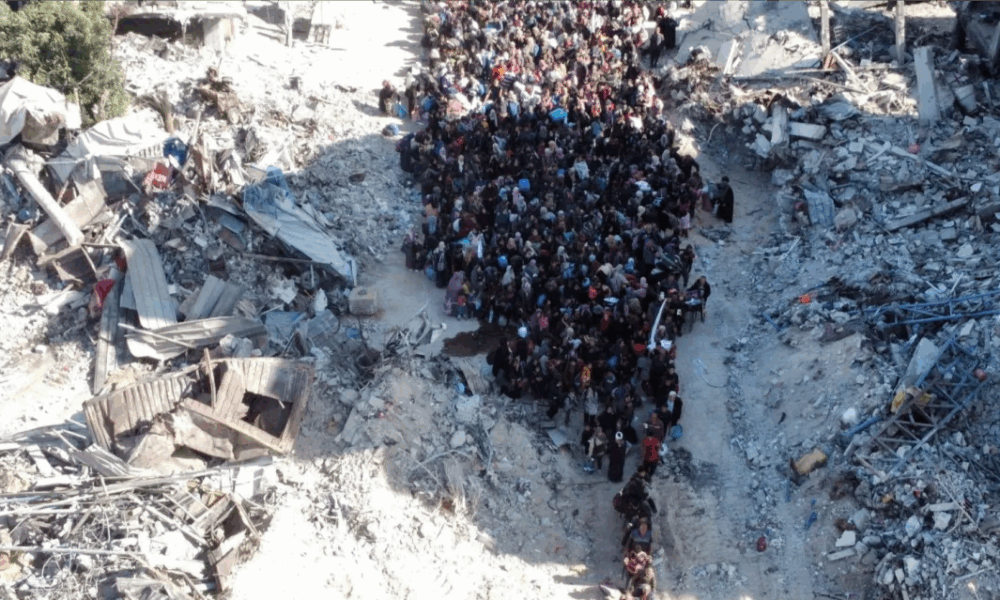Gaza Under Siege: Thousands Flee as Israeli Military Operations Escalate

The humanitarian crisis in Gaza City has intensified dramatically as thousands of Palestinians continue their exodus, fleeing a major Israeli ground offensive aimed at taking control of the area. This mass displacement follows a night of intense airstrikes and bombardment, which saw al-Rantisi children’s hospital reportedly hit in three separate incidents, forcing around half of its patients and their families to evacuate. The Israeli military has stated it is reviewing these reports, while also confirming it struck more than 150 "terror targets" across Gaza City over the past two days in support of its ground forces.
Israel's stated objective for its military campaign is to eliminate up to 3,000 Hamas fighters in what it describes as the group’s "last stronghold" and to secure the release of hostages. However, the offensive has triggered widespread global condemnation. More than 20 humanitarian organizations, including prominent groups like Save the Children and Oxfam, have urged global leaders to intervene, emphasizing that "the inhumanity of the situation in Gaza is unconscionable" and demanding "urgent intervention." Reports from other hospitals indicated that at least 35 people were killed by Israeli fire across Gaza on Wednesday, most of them in the north.
For days, vast numbers of Palestinians have been streaming southwards from Gaza City, utilizing whatever means available—donkey carts, rickshaws, overloaded vehicles, and on foot. Initially, they were restricted to a single coastal route leading to al-Mawasi, an area designated by Israel as a "humanitarian area." On Wednesday, the Israel Defense Forces (IDF) announced the temporary opening of a second evacuation corridor along Salah al-Din road, accessible for 48 hours. Despite this, many Palestinians face significant barriers to escape, primarily due to exorbitant travel costs. Some evacuees report that renting a small truck can now cost around 3,000 shekels ($900; £660), while a tent for five can reach as much as 4,000 shekels. Lina al-Maghrebi, a 32-year-old mother of three, recounted selling her jewelry to afford displacement and a tent, paying 3,500 shekels for a 10-hour journey to Khan Younis amidst endless lines of vehicles.
Humanitarian groups and UN agencies warn that the designated "humanitarian area" in al-Mawasi is severely overcrowded and utterly incapable of supporting the approximately 2 million Palestinians expected to arrive there. Some individuals who evacuated have reportedly returned north after finding no available space to set up tents. According to the IDF, around 350,000 people have left Gaza City, yet the UN estimates that 190,000 have evacuated since August, with approximately 650,000 residents still remaining in the city.
Adding to the complexity of the conflict, the IDF is reportedly deploying outdated military vehicles, packed with explosives and fitted for remote control, which are driven toward Hamas targets and detonated. Concurrently, families of the 48 hostages still believed to be held by Hamas, including 20 thought to be alive, have staged demonstrations near Prime Minister Benjamin Netanyahu’s residence in Jerusalem. They voiced grave concerns that the ongoing offensive could jeopardize the lives of their relatives. Macabit Mayer, whose niece and nephew are among the hostages, directly questioned the impact of the destruction, asking, “Bringing down buildings in Gaza – who are you bringing these buildings down on? Could it be that you are bringing these buildings down right now on Gali and Ziv and all the souls left there – the living and the deceased?”
The international backlash against Israel’s actions has been pronounced, with UN human rights chief Volker Türk calling the offensive “totally and utterly unacceptable,” and UK Foreign Secretary Yvette Cooper labeling it “utterly reckless and appalling.” In stark contrast, U.S. Secretary of State Marco Rubio signaled tentative support for Israel’s campaign, stating during a joint press event with Netanyahu that “sometimes when you’re dealing with a group of savages like Hamas, that’s not possible,” while still emphasizing a preference for a negotiated resolution. This diplomatic stance followed a United Nations Commission of Inquiry’s determination that Israel had committed genocide against Palestinians in Gaza. The report detailed that Israeli forces carried out sexual and gender-based violence, intentionally targeted children with lethal force, and launched a “systemic and widespread attack” on religious, cultural, and educational institutions. Israel’s foreign ministry vehemently rejected these findings, calling the report “distorted and false.”
The current escalation stems from the Hamas-led assault on southern Israel on October 7, 2023, which resulted in approximately 1,200 deaths and 251 hostages taken. Since then, Israeli operations in Gaza have led to at least 64,964 deaths, nearly half of whom are women and children, according to Gaza’s health ministry. With famine already declared in Gaza City by a UN-backed food security body, the United Nations warns that the latest offensive could plunge civilians into an “even deeper catastrophe.”
Recommended Articles
Gaza Horror: Hostages' Fate Unveiled Amidst Torture Claims and Urgent Search Efforts

Red Cross teams are actively searching Gaza for the remains of deceased hostages, a challenging operation following Isra...
Eurovision Shocker: Israel's Fate for Next Year's Contest Hangs in the Balance

The European Broadcasting Union has postponed a key vote on Israel's participation in the Eurovision Song Contest 2026, ...
Labour Conference Embroiled in Palestine Protests and Fiery Leadership Clashes

The Labour Party conference in Liverpool was marked by internal leadership challenges from Andy Burnham, who accused Sir...
Macron Issues Stark Warning: West Bank Annexation a 'Red Line' for US

French President Emmanuel Macron has revealed behind-the-scenes diplomacy regarding the Israel-Palestine conflict, stati...
UK Formally Recognizes Palestine, Joining Canada and Australia in Coordinated Diplomatic Move

The United Kingdom, led by Prime Minister Keir Starmer, has formally recognized Palestine as a state, joining Canada and...
You may also like...
Super Eagles Set Sights on AFCON 2025 Glory, Despite Doubts from Greek Champion

Super Eagles captain William Troost-Ekong aims for AFCON 2025 gold in Morocco, learning from past experiences and leadin...
NBA Rocked by Gambling Scandal: Players, Coaches, and League Grapple with 'Dire Risks'

The NBA is aggressively re-evaluating its stance on sports betting regulations and player protection following federal i...
Funding Frenzy in Tokyo: 'Filipinana' and 'Garuda' Make Waves at Gap-Financing Market

Two distinct cinematic ventures, Indonesian animated feature “Garuda: Dare to Dream” and Rafael Manuel’s debut live-acti...
Hollywood Shockwave: Paramount Skydance Axes 1,000 Employees Amidst Industry Upheaval

Paramount Skydance is set to cut approximately 1,000 jobs this week as part of a major cost-reduction initiative followi...
Music Meets Diplomacy: Shakira & The Weeknd Join Global Board with Star-Studded Lineup!

Shakira and The Weeknd have joined the FIFA Global Citizen Education Fund's Advisory Board, aiming to make education mor...
KPop Phenomenon: HUNTR/X's 'Golden' Dominates Global Charts for 13 Weeks!

HUNTR/X's "Golden" from <i>KPop Demon Hunters</i> reclaims the No. 1 spot on both Billboard Global 200 and Global Excl. ...
Must-Watch Horror Masterpiece (92% RT) Now Streaming For Free!

The critically acclaimed horror film 'Barbarian', boasting a 92% Rotten Tomatoes score, will soon be available for free ...
Major UK Airline, Serving 1.3 Million Annually, Faces Imminent Collapse!

Eastern Airways, a UK airline operating since 1997, is reportedly nearing administration after filing a notice of intent...